《科技英语文献阅读与翻译》Unit 1-TextB
科技英语阅读(李健版)翻译U1

大规模研究发现:地球的“健康”每况愈下有史以来对地球进行的最大规模的科学分析表明,地球上的许多生态系统都达不到标准。
由联合国主持的《千年生态系统评估综合报告》指出,由于不可持续的使用,地球上将近三分之二的用来维持生命的生态系统已经遭到破坏,其中包括干净的水源、纯净的空气,以及稳定的气候。
以上大部分的破坏都是人类在过去的半个世纪里造成的。
据报告分析,随着人类对食物、淡水、木材、纤维以及燃料等资源的需求日趋激增,环境发生了极大的变化,引发了诸如滥伐森林、化学污染等问题。
因此,该报告的作者警告说,照此下去,本已岌岌可危的生态环境将会在21世纪的上半叶急剧恶化。
这项历史性的研究由来自世界95个国家的政府部门以及民间组织的1,300多位科学家共同完成。
四年来,他们考察了地球上许多生物的生长环境、物种以及将他们联系起来的生态体系。
联合国环境规划署对该报告进行了编辑整理并于昨天在中国北京公布了研究结果。
在公布该报告的新闻发布会上,联合国秘书长科菲·安南指出:“只有了解环境及其运作过程,我们才能制定出必要的决策加以保护。
”他还说,“只有珍惜所有宝贵的自然资源和人类资源,我们才有希望去建设一个可持续发展的未来。
”对社会经济的影响该报告对自然界的大部分生物多样性持悲观态度,地球上可能有10%—30%的哺乳动物,鸟类以及两栖动物濒临灭绝。
这次大规模生态调查是根据安南的《千年发展目标》展开的,该发展目标是由联合国发起的,旨在2015年之前大幅度缓解饥饿与极度贫困等社会经济问题。
总部位于内罗毕的联合国环境规划署执行主席克劳斯·托普弗说:“从某些方面来说,《千年生态系统评估综合报告》让我们首次认识到生态系统服务功能的经济价值,并使我们对尊重和保护地球生命维护系统有了新的见解。
”目前由于人类社会对地球环境的开发利用,食物供应不断增加,然而增长的速度仍然太慢,难以完成联合国制定的在2015年前消除全球一半饥饿的目标。
文献阅读与翻译 Unit 1李
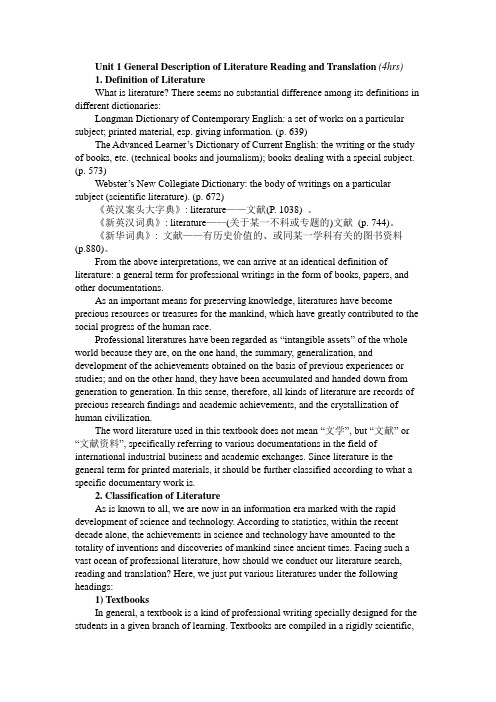
Unit 1 General Description of Literature Reading and Translation (4hrs)1. Definition of LiteratureWhat is literature? There seems no substantial difference among its definitions in different dictionaries:Longman Dictionary of Contemporary English: a set of works on a particular subject; printed material, esp. giving information. (p. 639)The Advanced Learner‟s Dictionary of Current English: the writing or the study of books, etc. (technical books and journalism); books dealing with a special subject. (p. 573)Webster‟s New Collegiate Dictionary: the body of writings on a particular subject (scientific literature). (p. 672)《英汉案头大字典》: literature——文献(P. 1038) 。
《新英汉词典》: literature——(关于某一不科或专题的)文献(p. 744)。
《新华词典》: 文献——有历史价值的、或同某一学科有关的图书资料(p.880)。
From the above interpretations, we can arrive at an identical definition of literature: a general term for professional writings in the form of books, papers, and other documentations.As an important means for preserving knowledge, literatures have become precious resources or treasures for the mankind, which have greatly contributed to the social progress of the human race.Professional literatures have been regarded as “intangible assets” of the whole world because they are, on the one hand, the summary, generalization, and development of the achievements obtained on the basis of previous experiences or studies; and on the other hand, they have been accumulated and handed down from generation to generation. In this sense, therefore, all kinds of literature are records of precious research findings and academic achievements, and the crystallization of human civilization.The word literature used in this textbook does not mean “文学”, but “文献” or “文献资料”, specifically referring to various documentations in the field of international industrial business and academic exchanges. Since literature is the general term for printed materials, it should be further classified according to what a specific documentary work is.2. Classification of LiteratureAs is known to all, we are now in an information era marked with the rapid development of science and technology. According to statistics, within the recent decade alone, the achievements in science and technology have amounted to the totality of inventions and discoveries of mankind since ancient times. Facing such a vast ocean of professional literature, how should we conduct our literature search, reading and translation? Here, we just put various literatures under the following headings:1) TextbooksIn general, a textbook is a kind of professional writing specially designed for the students in a given branch of learning. Textbooks are compiled in a rigidly scientific,systematic and logical way. Comparatively, the content of a textbook is mature and well established, because it has been compiled through the writer‟s careful selection, verification, discrimination, integration and comprehensive study of the subject. If you intend to acquire a general knowledge of a certain subject over a larger area, or if you want to have a preliminary understanding of a certain issue, you‟d better go over the relevant textbooks, which proves the best policy.2) MonographsA monograph is “an arti cle or short book on one particular subject or branch of a subject that the writer has studied deeply” (Longman Dictionary of Contemporary English, p. 704). It is also a “detailed scientific account, esp. a published report on some item of research” (The Advanced Learner‟s Dictionary of Current English, p. 632). The content of a monograph usually includes the history and present status of a particular subject, observed data, experimental methods and results, existing problems and the developing trend, various viewpoints and discussions of different schools of thought, research achievements and further exploration, and so on. A monograph usually functions as an important guide for the reader to understand the particular study comprehensively and deeply.3) PapersPapers are the most important and reliable sources for textbooks, monographs, and all the other documentary works. A complete paper is usually composed of the following elements: title, author, affiliation, abstract, keywords, introduction, theoretical analysis and/or experimental description, results and discussion or conclusion, acknowledgments, references, etc. (detailed description and exemplification of these elements in a professional paper are given in a separate textbook entitled Paper Writing and Publication, by Hu Gengshen, et al., Beijing: Higher Education Press, 2000.) A paper usually deals with a relatively specific topic, and with a comparatively narrow subject.4) EncyclopediasAn encyclopedia is “a book or set of books dealing with every branch of knowledge, or with one particular branch, in alphabetical order.” The difference between a dictionary and an encyclopedia is that “A dictionary explains words and an encyclopedia explains facts.” (Longman Dictionary of Contemporary English, p.361) As a basic reference book of generalized and summarized knowledge, an encyclopedia is usually compiled by many experts of many branches through many years. The contents of an encyclopedia, therefore, are comparatively mature and correct. It virtually serves as an important information retriever, providing comprehensive and systematic information about everything.The information retriever as such also includes yearbooks, dictionaries, guides, handbooks, and the like.5) PeriodicalsA periodical is a series of publications that appear at regular intervals. Periodicals are of various categories. From the perspective of names, for example, they are journals, acta, magazines, bulletins, rapid communications, letters, proceedings, records, abstracting services, reviews, indexes, etc., which constitute themain body of literature.Periodicals are characterized by being large in number and in variety, extensivein content and in circulation, mixed in language and in form, etc.Along with the rapid development of science and technology, periodicals have been rapidly increasing and have‟ been gradually professionalized, integrated and computerized.6) Special DocumentationThe so-called special documentation refers to all the printed materials that are non-books or non-periodicals. This special documentation mainly includes: standards, patent documents, trademarks, copyrights, contracts/agreements, reports, conference papers, dissertations (or theses), Product specifications, government publications, proposals, technical archives, electronic hypertexts, etc. Though neither books nor periodicals published regularly or publicly, the special documentation proves to be most effective resources for information retrieval. Insofar as literature search and reading are concerned, this kind of special documentation should not be overlooked. On the contrary, it calls for our special attention--that is why we have placed special emphasis on special documentation in the present textbook.Notes:1. journals, Acta, magazines, bulletins, rapid communications, letters, proceedings, records, abstracting services, reviews, indexes, etc. 会刊,学报,杂志,通报,快讯,通信稿,会议录,文献记录,世界文摘服务,评论,索引等2. hypertext 超级文本(指信息高速公路上的文件)3. Linguistic Features of Scientific LiteratureStylistically, literature is a kind of formal writing. Compared with an informal writing which usually utilizes an informal tone and colloquial language, a formal writing is a more serious approach to a subject of great importance and it avoids all colloquial expressions. Since the functions of scientific literature are to reveal creative research achievements, facilitate professional information retrieval, and help improve the development of science and technology, it deals objectively with the study of facts or problems; analyses on literature are based on relevant data, not on personal feelings, and discussions or conclusions are made on the basis of specific experiments or investigations.Syntactically, scientific literature has rigorous grammatical structures, and in most cases is rather unitary. Frequently used are indicative sentences, imperative sentences, complex sentences, and “It be + adj. (participle) + that ...” sentence patterns, etc.Morphologically, scientific literature is featured by high specialization, the use of technical terms and jargons, unambiguous implication and the fixed sense of the word. There are more compound words, Latin and Greek words, contracted words, noun clusters and so on in scientific literature than in other informational writing.Besides, non-verbal language is also very popular in various literatures such as signs, formulas, charts, tables, photos, etc. for the sake of accuracy, brevity, and clarity.Different literatures may have different linguistic features although they do havesimilar characteristics in common. The linguistic features of an individual literature will be discussed together with the specific category of documentation in the corresponding Unit of this textbook. To learn the linguistic features of various literatures will be beneficial not only to documentation reading but also to the translation and writing of such documentary works.4. Search for Relevant LiteratureThe search for relevant literature needed for professional study and research has become a practical skill for professionals. This is important because an effective way of literature search and reading will facilitate our information retrieval within a shorter period of time. In fact, everyone may have his/her own way of literature search and reading. And the following are some usual approaches:1) Global SearchBy “global search” we mean to search for materials around the subject in a larger dimension or within a wider range, i.e., conducting the extensive reading. For example:(1) Search for relevant books through the Classified and Specified Catalogues.(2) Search for periodicals through the Newspapers and Journals Indexing.(3) Search for domestic literature through the Domestic Sci-tech Data Catalogues.(4) Search for current foreign literature through the Sci-Tech Translation Bulletin.(5) Search for literature at home and abroad through INTERNET, WWW (World Wide Web), and other electronic retrieval means.2) Specific SearchBy “specific search” we mean to search for literature about a certain topic withina specific area or in a narrower scope. For example:(1) Select some most-related papers for intensive reading.(2) Expand the scope of the reading only on the basis of the references of the selected papers.(3) Try to find out relevant “reviews” on the topic so as to know the authoritative comments, the experts‟ views, the global developing trend and the general on-goings, etc.3) Processed SearchBy “processed search” we mean to accumulate and absorb essential information in the course of literature search and reading. For example:(1) Store the searched literature by careful note-taking and self-abstracting.(2) Sort out the searched documentation by timely putting them into different categories.(3) Digest/Absorb the searched information by creatively analyzing and synthesizing.It is very important to identify and then make generalization of the essential parts of the research papers, because the author of a paper should and must present his/her achievements or research findings through these parts. For this purpose, as a researcher, one has to be good at doing retrieval reading. By retrieval reading wemean retrospect reading of the manuscript in a very careful way so as to identify, register and generalize the gist or the main parts of work, or contributions we have made in a given paper. Literally, we mean reading the manuscript in a thorough manner and making notes: (1) as to the subjects dealt with, particularly subjects concerning with new information given incidentally; and (2) as to the new result and conclusive ideas reported. Material relating to each subject should then be gathered together in a logical way; and (3) all the sentences generalizing the main ideas of all the original materials should be put together so as to be well-versed, abstract-brief, condensed, complete, yet easily readable.In the final analysis, to digest and absorb useful information is the ultimate purpose of literature search and reading. This is a process of discarding the dross and selecting the essential, eliminating the false and retaining the true, proceeding from the easy to the difficult and from the outer to the inner. It is also a process of reading, selecting, sorting, synthesizing, commenting, rationalizing, systematizing, reprocessing, etc.One thing that needs to be mentioned is that an awareness of information discrimination is highly necessary, for the collection and absorption of erroneous knowledge and information is harmful. Just as a western scientist says: “The fool collects data and the wise man selects them.” This remark, th ough drastic, is indeed philosophical.Notes1. through the Classified and Specified Catalogues 通过《分类目录或专题目录》2. through the Newspapers and Journals Indexing 通过《全国报刊索引》3. through the Domestic Sci-Tech Data Catalogues 通过《国内资料科技目录》4. Sci-Tech Translation Bulletin 《科技译文通报》5. the fool collects data and the wise man selects them 愚者采集资料,智者选择资料5. Review of this chapterDefinition of Literature: a set of works on a particular subject; printed material, esp. giving information; the body of writings on a particular subject (scientific literature)Classification of Literature: textbooks, monographs, papers, encyclopedias, periodicals, special documentation, etc.Linguistic Features of Scientific Literature: stylistically, a kind of formal writing, with rigorous and unitary grammatical structure, highly specialized and unambiguous wording for semantic accuracy, etc.Search for Relevant Literature: global search, specific search, and processed search Supplementary Readings on Informational Retrieval: retrieval system, microfilm, internet. database, reformat, on, e-mail, information infrastructure, information superhighwayTranslation Skills (1): Translation in General and Translation of Special LiteratureTranslation is a rendering of ideas or concepts from one language into another,i.e., the faithful representation in the target language of what is written or said in the original language.As a means of communication, translation plays an important role in human civilization. In the West, literary translation can be traced back to 300 BC; while in China, recorded translation activities are even earlier, dating from Zhou Dynasty (1100 BC). However, not until the recent centuries, especially by the end of the 19th century did systematic study of translation get under way. The recent decades have seen rapid development in translation theories and translation activities both at home and abroad.A modern society sees an extensive use of translation on various occasions. Proper and dexterous translation helps promote mutual understanding between peoples of different cultural and social backgrounds, whereas improper rendering of words or expressions leads to confusion. Take the ordinary word “menu” for example. Its original meaning is “a list of dishes in a meal or to be ordered as separated meals, esp. in a restaurant”, and the Chinese equivalent seems to be clear: 菜单. However, when it is used in computer science, its meaning shifts to “a list shown on the display of a computer from which a user can select the operation the computer is to perform.”Evidently the Chinese counterpart should be something like “选项、项目单” It is a pity that the initial translator neglected this definition, and as a result, this very popular term of computer science fails to convey its true meaning in Chinese--the translated term”菜单” sounds incongruous with its actual content. So is the rendering of “Renaissance”--commonly known as “文艺复兴” in Chinese. Although we know today that the movement extended far beyond the literature and art circle, and the connotation of “Renaissance” is much more profound than that of the Chinese term “文艺复兴”, yet it is generally accepted through common practice. Such improper rendering is not uncommon in Chines-English translation. A sweet and melodious trademark in Chinese, by improper translation, may cause uneasiness or even create a loathsome image in the mind of people of different social and cultural backgrounds. For example, a popular Chinese lipstick with the trademark “芳芳”, when transliterated into English as “Fangfang”, assumes a hideous image--the English word “fang” happens to have two disagreeable definitions: a, a long, sharp tooth of a dog; b.a snake‟s poisonous tooth. Consequently, this awkward transliteration has resulted in a complete failure in marketing. Similar translation blunders are not unusual in social or economic activities in our country. To name a few, translating “五讲四美、三热爱”into “five stresses, four beauties and three loves”, “抓紧施肥” into “grasp manure”, “街道妇女” into “street women”, “白酒”into “white wine”, etc. Had the translators had sufficient translation knowledge, such blunders would have been avoided.1. Nature and Scope of TranslationWhat is translation? Some people believe it is a science, others take it as an art; and yet many consider it a craft, or rather, a skill.Of these varied definitions, which one holds true for our purpose? The answer depends on how w e understand or interpret the word “translation”, for the very word “translation” itself is ambiguous. And the Chinese equivalent fanyi sounds even fuzzier. Fanyi, in Chinese, may either stand for a subject in the curriculum, a jobpeople engage in, a piece of literary work, or the translating or interpreting work itself. Sometimes, fanyi may even refer to the translator or interpreter himself/herself.If the word “translation” refers to a subject, namely, the study of translation theory and skills, it is no doubt a science, just as any subject is, with its own rules, laws and principles for the translators to observe; however, if it refers to some specific pieces of translation, then it is more like an art, with each piece of them manifesting its own charms and style in the creative hands of the translator; whereas, if it refers to a process, in which something is translated, then we may regard it as a craft or skill. For unlike any branch of natural science, the process of translation has its own nature, and none of its rules and principles are universally applicable. Therefore, it entails a lot of practice, and particular craftsmanship and skills are reflected by the touches of different translators.Translation covers a very broad range. In terms of languages, it can be divided into two categories: from native languages into foreign languages and vice versa; in terms of the mode, it can be divided into oral interpretation and written translation; in terms of materials to be translated, there are translation of scientific materials, translation of literary works such as novels, stories, prose, poetry, drama, etc., translation of political essays such as treatises on social problems, repons, speeches, etc., and translation of practical writing (as official documents, contracts and agreements, notices, receipts, etc.); in terms of disposal, it can be either full-text translation, abridged translation or adapted translation.2. Principles or Criteria of TranslationThe so-called principles and criteria of translation are actually the two sides of the same coin. That is, on the part of the translator, he or she should follow them while translating; whereas on the part of the reader or critic, he or she may use the principles and criteria to evaluate translation works. Whenever principles or criteria of translation are under discussion in China, Yan Fu‟s “three-character guide”--xin, da, ya, namely, “faithfulness (信), expressiveness (达), and elegance (雅)”, which was first proposed in 1898, would evoke controversy.In the past decades, Mr. Yan‟s principle has always been regarded as aplumb-line for measuring the professional level of translation and a goal for translators to strive after. However, in the application of this principle, people come to find some unsatisfactory aspects of the three-character guide and have put foreword a variety of new standards or criteria of translation.Despite a variety of opinions, two criteria are almost unanimously accepted by all, namely, the criterion of faithfulness/accuracy (忠实/准确) and that of smoothness (流畅). We may also take these two criteria as the principles of scientific literature translation. By faithfulness/accuracy, we mean to be faithful not only to the original contents, to the original meaning and views, but also to the original form and style. By smoothness, we mean not only easy and readable rendering, but also idiomatic expression in the target language, free from stiff formula and mechanical copying from dictionaries.3. Literal Translation and Free TranslationThe process of translation consists of two phases: comprehension and expression.Generally speaking, comprehension is of foremost importance, and expression is the natural consequence of thorough comprehension. However, in the practice we may find that now and then some words or phrases in their usual senses are very difficultto deal with because of the disparity between English and Chinese. In this case, we have to resort to some special means of translation. Literal translation (直译) and free translation (意译) are two dynamic approaches in dealing with such awkward situations.The so-called literal translation, superficially speaking, means “not to alter the original words and sentences”; strictly speaking, it strives “to keep the s entiments and style of the original.” It takes sentences as its basic units and takes the whole text (discourse) into consideration at the same time in the course of translation. Furthermore, it strives to reproduce both the ideological content and the style of the original works and retains as much as possible the figures of speech. There are quite a lot of examples of successful literal translation that have been adopted as idiomatic Chinese expressions. For example, crocodile‟s tears (鳄鱼的眼泪), armed to the teeth (武装到牙齿), chain reaction (连锁反应), gentlemen‟s agreement (君子协定), and so on. Similarly, some Chinese idioms also find their English counterparts through literal translation. For example, 纸老虎(paper tiger),一国两制(one country, two systems ), and so on.Free translation is an alternative approach which is used mainly to convey the meaning and spirit of the original without trying to reproduce its sentence patterns or figures of speech. This approach is most frequently adopted when it is really impossible for the translator to do literal translation. For example:Adam‟s Apple 喉结at sixes and sevens 乱七八槽It rains cats and dogs. 大雨滂沱Don‟t cross the bridge till you get to it. 不必担心过早。
大学科技英语课文翻译Unit 1-7
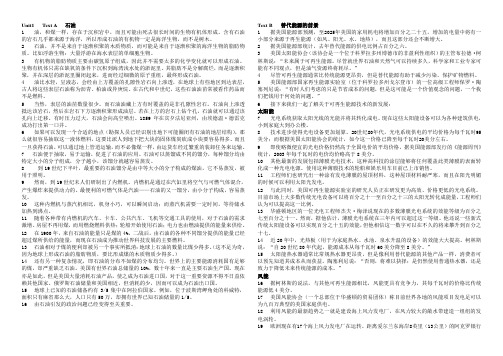
Unit1 Text A 石油1油,和煤一样,存在于沉积岩中,而且可能由死去很长时间的生物有机体形成。
含有石油的岩石几乎都来源于海洋,所以形成石油的有机物一定是海洋生物,而不是树木。
2 石油,并不是来自于逐渐积聚的木质物质,而可能是来自于逐渐积聚的海洋生物的脂肪物质。
比如浮游生物:大量浮游在海水表层的单细胞生物。
3 有机物的脂肪物质主要由碳氢原子组成,因此并不需要太多的化学变化就可以形成石油。
生物有机体只需在缺氧的条件下沉积到海湾浅水处的淤泥里。
其脂肪不是分解腐烂,而是逐渐积聚,并在深层的淤泥里圈闭起来,进而经过细微的原子重组,最终形成石油。
4 油比水轻,呈液态,会经由上方覆盖的孔隙性岩石向上渗透,在地球上有些地区到达表层,古人将这些表层石油称为沥青、柏油或异庚烷。
在古代和中世纪,这些石油油苗常被看作药品而不是燃料。
5 当然,表层的油苗数量很少。
而石油油藏上方有时覆盖的是非孔隙性岩石。
石油向上渗透抵达该岩石,然后在岩石下方逐渐积聚形成油层。
若在上方的岩石上钻个孔,石油就可以通过该孔向上迁移。
有时压力过大,石油会向高空喷出。
1859年在宾夕法尼亚州,由埃德温·德雷克成功打出第一口井。
6 如果可以发现一个合适的地点(勘探人员已经识别出地下可能圈闭有石油的地层结构),那么就很容易抽取这一液体燃料,这要比派人到地下把大块的固体煤炭砍成小块要容易得多。
而且一旦获得石油,可以通过地上管道运输,而不必像煤一样,由运货车经过繁重的装卸任务来运输。
7 石油便于抽取,易于运输,促进了石油的应用。
石油可以蒸馏成不同的馏分,每种馏分均由特定大小的分子组成,分子越小,该馏分就越容易蒸发。
8 到19世纪下半叶,最重要的石油馏分是由中等大小的分子构成的煤油,它不易蒸发,被用于照明。
9 然而,到19世纪末人们研制出了内燃机。
内燃机是通过在汽缸里将空气与可燃气体混合,产生爆炸来提供动力的。
最便利的可燃气体是汽油——石油的又一馏分,由小分子构成,容易蒸发。
科技英语阅读翻译
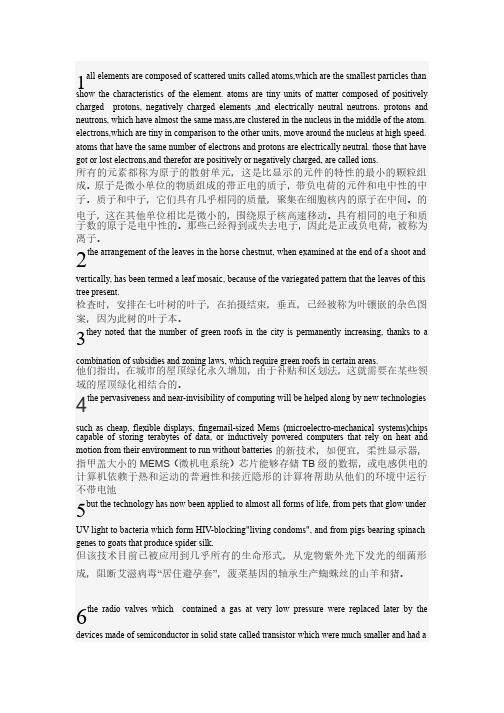
1all elements are composed of scattered units called atoms,which are the smallest particles than show the characteristics of the element. atoms are tiny units of matter composed of positively charged protons, negatively charged elements ,and electrically neutral neutrons. protons and neutrons, which have almost the same mass,are clustered in the nucleus in the middle of the atom. electrons,which are tiny in comparison to the other units, move around the nucleus at high speed. atoms that have the same number of electrons and protons are electrically neutral. those that have got or lost electrons,and therefor are positively or negatively charged, are called ions.所有的元素都称为原子的散射单元,这是比显示的元件的特性的最小的颗粒组成。
原子是微小单位的物质组成的带正电的质子,带负电荷的元件和电中性的中子。
质子和中子,它们具有几乎相同的质量,聚集在细胞核内的原子在中间。
的电子,这在其他单位相比是微小的,围绕原子核高速移动。
具有相同的电子和质子数的原子是电中性的。
21世纪科技英语Unite1 textB翻译

1-2 美国政府计划推出一个重大机构间主动培育,纳米技术称为爆炸性增长的科学兴趣的行为的材料在纳米尺度。
国家科学基金会(基金会),它支持大多数大学的研究,在纳米科学和有可能导致倡议,报告说,它可以基金只有13%的拨款申请,它接收到的领域,而40%的成功率在许多学科在办事处。
3 资金竞争领域中是“绝对凶残,”斯坦说,威廉姆斯,头的基础研究在惠普和积极支持的倡议。
威廉姆斯喜欢的纳米技术纳米技术因为后者已成为柏油的幻想的索赔代表它。
4 “问题是,纳米技术已经过头了,”他说,“我们没有恐惧与厌恶,有些人认为,联想长期愿景的一个厂安置在一个火柴盒。
5 相反,越来越多的认识材料在纳米尺度,在尺寸可比的长度个别分子,可能是把大型产品和过程。
”这是不需要的小东西,它可能是在汽车,”解释克罗可的国家科学基金会的工程,谁主持一个机构间工作组,正在规划的倡议。
”利用纳米技术是非常广泛的,但所有领域,它使用相同的工具和方法。
”6 也许最壮观的应用迄今使用巨磁电阻在1988发现。
在读取头的计算机磁盘驱动器。
相关现象的隧道磁阻不久将允许生产的快速和紧凑的随机存取存储器计算机。
7 但是,正如威廉姆斯指出的,迫在眉睫的纳米技术的应用远远超出了计算机行业。
柯达,他说,发展纳米颗粒称为“染色精”-一个跨之间的粉末颜料和染料分子在印刷图像使用。
轮胎制造商计划和纳米粘土与橡胶轮胎,收尾的聚合物分子和大大延长轮胎的使用寿命。
而五分之四的可能的药物疗法,不可测试的患者因为它们是不溶于水,能产生纳米粒子在水中悬浮,并可能因此成为可行的治疗候选人。
8 所有这种潜力是吸引注意在华盛顿,在支持研究倡议越来越多。
在年度预算准则分发给机构可能,杰克卢主任,管理和预算办公室在白宫,尼尔巷,主任办公室的科学和技术政策,确定纳米技术作为一种成熟的特殊机构间关注。
上月,听证会在众议院和参议院概述了潜在的领域。
9 这一切指向重大加入纳米技术倡议的预算提案的2001财年,,克林顿总统向国会明年二月。
科技英语论文阅读及翻译PPT课件
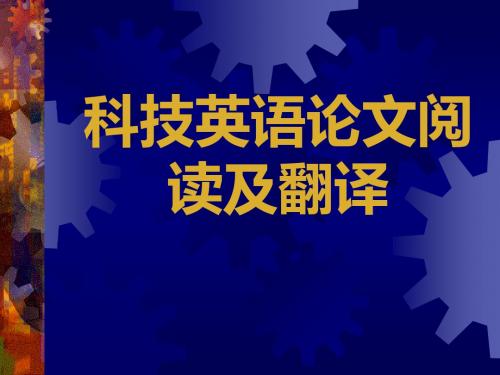
(2)描述方法
Multiple faults of injector were simulated on the experimental table, and acoustic signals that sent out by working diesel were collected over the cylinder head. Using wavelet and neural network technology, this paper analyzed the acoustic signals in detail and diagnosed the different faults successfully.
论文内容本身(text)
5)致谢(acknowledgement) 6)参考文献(reference)
作者姓名、文章标题、杂志名称、 卷号和页码、刊登的月份和年份。
署名
作者姓名
作者的姓名要用全称(full name) 外国人的姓名分三部分:
教名-Christian name, first name, given name, forename 中间名-middle name 姓-surname, family name, last name 中国人的姓名应根据中国人的习惯,按汉语的顺序以汉语 拼音写出 Transfer Characteristics in Mechanically Stirred Airlift Loop Reactors with or Without Static Mixers Lü Xiaoping, Wang Yanru
Key words : hybrid electric vehicle petroleum substitution Battery
科技英语阅读与翻译全文

科技英语阅读与翻译全文Humanitarian Aid in SpaceSpace exploration technology will benefit developing countries in a variety of ways. Whether it's information about climate change or communication technologies that give remote areas access to the world outside, space science can come to the aid of vulnerable people in many countries.For the past two decades, Japan Aerospace Exploration Agency (JAXA) has been sending humanitarian aid dispatched from its space platform. This ambitious project has proved successful, and it’s been praised for its achievements in various aspects.The two strategic areas set forth for JAXA’s humanitarian aid effort are science and education. JAXA’s donations of books and puzzle sets are enabling elementary and junior high school kids in India to study science and math. There are plans to utilize remote sensing data to map out natural resources in Nepalese countryside and expand education related to environmental issues in Vietnam. In addition the agency is sending educational videos to the island nation of Palau tobetter understand their own local wildlife.JAXA is considered to be a pioneer in this area since the launch of their humanitarian aid initiative in 1997. The organization strives to make use of space applications for social welfare and reduce disparities in the world through a number of practical endeavors. The effort currently has a global reach, with projects taking place in seven continent, from Latin America to Africa.JAXA’s humanitarian aid programs will continue to grow with better technology and increased resources. The ongoing work reinforces the concept that space science and technology have the potential to contribute to enhancing the lives of people on Earth.人道主义援助在太空太空探索技术将在各个方面受益于发展中国家。
科技英语课文翻译及课后答案
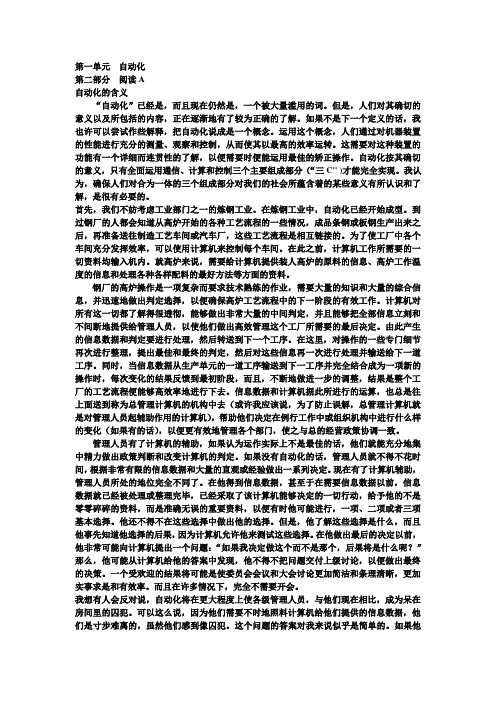
第一单元自动化第二部分阅读A自动化的含义“自动化”已经是,而且现在仍然是,一个被大量滥用的词。
但是,人们对其确切的意义以及所包括的内容,正在逐渐地有了较为正确的了解。
如果不是下一个定义的话,我也许可以尝试作些解释,把自动化说成是一个概念。
运用这个概念,人们通过对机器装置的性能进行充分的测量、观察和控制,从而使其以最高的效率运转。
这需要对这种装置的功能有一个详细而连贯性的了解,以便需要时便能运用最佳的矫正操作。
自动化按其确切的意义,只有全面运用通信、计算和控制三个主要组成部分(“三C" )才能完全实现。
我认为,确保人们对合为一体的三个组成部分对我们的社会所蕴含着的某些意义有所认识和了解,是很有必要的。
首先,我们不妨考虑工业部门之一的炼钢工业。
在炼钢工业中,自动化已经开始成型。
到过钢厂的人都会知道从高炉开始的各种工艺流程的一些情况,成品条钢或板钢生产出来之后,再准备送往制造工艺车间或汽车厂,这些工艺流程是相互链接的。
为了使工厂中各个车间充分发挥效率,可以使用计算机来控制每个车间。
在此之前,计算机工作所需要的一切资料均输入机内。
就高炉来说,需要给计算机提供装人高炉的原料的信息、高炉工作温度的信息和处理各种各样配料的最好方法等方面的资料。
钢厂的高炉操作是一项复杂而要求技术熟练的作业,需要大量的知识和大量的综合信息,并迅速地做出判定选择,以便确保高炉工艺流程中的下一阶段的有效工作。
计算机对所有这一切都了解得很透彻,能够做出非常大量的中间判定,并且能够把全部信息立刻和不间断地提供给管理人员,以使他们做出高效管理这个工厂所需要的最后决定。
由此产生的信息数据和判定要进行处理,然后转送到下一个工序。
在这里,对操作的一些专门细节再次进行整理,提出最佳和最终的判定,然后对这些信息再一次进行处理并输送给下一道工序。
同时,当信息数据从生产单元的一道工序输送到下一工序并完全结合成为一项新的操作时,每次变化的结果反馈到最初阶段,而且,不断地做进一步的调整,结果是整个工厂的工艺流程便能够高效率地进行下去。
- 1、下载文档前请自行甄别文档内容的完整性,平台不提供额外的编辑、内容补充、找答案等附加服务。
- 2、"仅部分预览"的文档,不可在线预览部分如存在完整性等问题,可反馈申请退款(可完整预览的文档不适用该条件!)。
- 3、如文档侵犯您的权益,请联系客服反馈,我们会尽快为您处理(人工客服工作时间:9:00-18:30)。
private key
It is the key for use with asymmetric
encryption that is accessible to the key holder only. Asymmetric encryption uses different keys for encryption and decryption. Each participant is assigned a pair of keys, consisting of an encryption key and a corresponding decryption key. A private key is used for generating digital signatures and for decrypting data.
2012-7-25 Unit One Text B Digital Signature in Applied Cryptography 6
hash function and hash value
When hashing a message, the message is
converted into a short bit string--a hash value-and it is impossible to re-establish the original message from the hash value. A hash value is unique in the sense that two messages cannot result in the same bit string, and any attempt to make changes to the message will negate the value and thus the signature.
Unit One
Text B
Digital Signature in Applied Cryptography
Background Information
2012-7-25
Unit One Text B Digital Signature in Applied Cryptography
2
cryptography
2012-7-25 Unit One Text B Digital Signature in Applied Cryptography 8
source code
Source code is any series of statements written
in some human-readable computer programming language. In modern programming languages, the source code which constitutes a program is usually in several text files, but the same source code may be printed in a book or recorded on tape (usually without a file system). The term is typically used in the context of a particular piece of computer software.
2012-7-25 Unit One Text B Digital Signature in Applied Cryptography 13
Encrypting with a private key thus can be regarded as an equivalent to placing one’s signature on the
2012-7-25 Unit One Text B Digital Signature in Applied Cryptography 3
public key
It is the key for use with public key encryption
methods that is publicly made available. It is published by the key holder or the issuing certification authority. The certification authority’s directory server can distribute it by disk, web download or e-mail. The public key can be certified using an electronic certificate issued and signed by a certification authority.
private conversation Nowadays many eavesdroppers are able to connect to your personal computer and phone networks. eavesdrop v. listen secretly to private conversation of others A new law has been approved by the congress to allow to eavesdrop on private phone conversations.
2012-7-25 Unit One Text B Digital Signature in Applied Cryptography 9
Language Points
2012-7-25
Unit One Text B Digital Signature in Applied Cryptography
the corresponding private key. (para. 3):
In public key cryptography, anything
Alice encodes with Bob’s public key can be decoded by Bob with the matching private key. 译文: 在公钥密码系统里, 艾丽斯用鲍 勃的公钥加密的任何内容都可以被鲍 勃用对应的私钥解密.
v. 1) to link or associate together, connect
eg: Pressure, coupled with nervousness
made it hard for the president candidate to fall asleep. 2) to join as spouses, marry eg: Falling in love at the first sight, they coupled as a perfect match.
2012-7-25 Unit One Text B Digital Signature in Applied Cryptography 7
digital cash
Digital cash is a digitally signed payment message
that serves as a medium of exchange. Digital cash is a system of purchasing cash credits in relatively small amounts, storing the credits in your computer, and then spending them when making electronic purchases over the Internet. Theoretically, digital cash could be spent in very small increments, such as tenths of a cent (U.S.) or less. Most merchants accept digital cash so far, however, they also use it as an alternative to other forms of payment for somewhat higher price purchases.
10
This means that an eavesdropper, refers to Eve, will not
be able to listen in on their communication. (para. 1):
eavesdropper n. a person who listens secretly to
Cryptography is the study of mathematical
techniques related to aspects of information security such as confidentiality, data integrity, entity authentication, and data origin authentication. As the Internet and other forms of electronic communication become more prevalent, electronic security is also becoming increasingly important. Cryptography is used to protect e-mail messages, credit card information, and corporate data.
